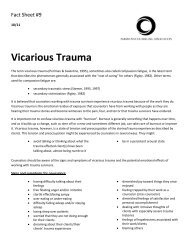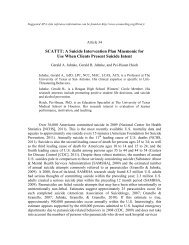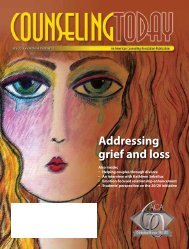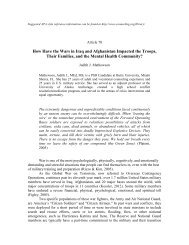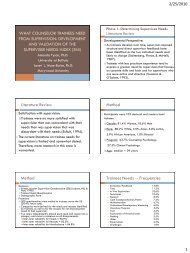Jungian Play Therapy - American Counseling Association
Jungian Play Therapy - American Counseling Association
Jungian Play Therapy - American Counseling Association
You also want an ePaper? Increase the reach of your titles
YUMPU automatically turns print PDFs into web optimized ePapers that Google loves.
Suggested APA style reference:<br />
Green, E. J. (2005). <strong>Jungian</strong> play therapy: Bridging the theoretical to the practical. In G.<br />
R. Walz & R. K. Yep (Eds.), VISTAS: Compelling perspectives on counseling, 2005 (pp.<br />
75-78). Alexandria, VA: <strong>American</strong> <strong>Counseling</strong> <strong>Association</strong>.
Article 15<br />
<strong>Jungian</strong> <strong>Play</strong> <strong>Therapy</strong>: Bridging the Theoretical to the Practical<br />
Eric J. Green<br />
Sexual abuse of young children may produce deep<br />
psychical scars: children may internalize the aberrant<br />
feelings, images, and bodily sensations associated with<br />
abuse, which obfuscates and obstructs psychological<br />
development (Allan & Bertoi, 1992; Allan & Brown,<br />
1993). <strong>Jungian</strong> play therapy promotes psychical<br />
healing by emphasizing the salience of the positive<br />
therapeutic dyad and encouraging the emergence of the<br />
self-healing archetype that is embedded within<br />
children’s psyches (Allan, 1988). Once the self-healing<br />
archetype unfolds within the therapeutic container,<br />
children will play out themes significant to their inner<br />
struggles (Thompson & Allan, 1987). By reconciling<br />
polarities that surface within the playroom, <strong>Jungian</strong> play<br />
therapists facilitate children’s inner healing by working<br />
through complexes centering on internal struggles,<br />
which may include the dichotomies of good and evil,<br />
shame and pride, and condemnation and redemption<br />
(Kalsched, 1996).<br />
<strong>Jungian</strong> <strong>Play</strong> <strong>Therapy</strong> Rationale<br />
With its origins in psychoanalytic theory, <strong>Jungian</strong><br />
play therapy focuses on the psyche’s role in personality<br />
development. Jung (1963) explained that the evolving<br />
nature of the collective unconscious, with its archetypal<br />
manifestations, influences the process of individuation.<br />
Individuation characterizes a progression from<br />
psychic fragmentation toward wholeness—the<br />
acknowledgement and reconciliation of opposites<br />
(Jung, 1964).<br />
<strong>Jungian</strong> theory describes the instinctive yearnings<br />
in humans as archetypal remnants that are motivated<br />
by a psychospiritual proclivity for growth and soulful<br />
evolution. Jung (1959) believed humans have a capacity<br />
for conscious self-growth through innate symbols, or<br />
archetypes. Allan (1988) stated the self-healing<br />
archetype is an innate symbol that promotes<br />
psychospiritual healing by recognizing and achieving<br />
a balanced intrapsychic communication between the<br />
ego and the self.<br />
<strong>Jungian</strong> play therapy is a spiritualized approach<br />
to counseling children and emphasizes symbolic<br />
meaning (Jung, 1959). Jung believed that children<br />
contain a transcendent function—an innate striving for<br />
wholeness and personality integration that occurs by<br />
symbolic identification (Jung, 1963). Symbols are<br />
produced unconsciously and appear most commonly<br />
in dreams, artwork, and fantasies. <strong>Jungian</strong>s grasp<br />
children’s symbols only in the context of the<br />
macrosystem in which they are contained (Allan, 1988).<br />
Allan and Bertoi (1992) stated that one reason<br />
<strong>Jungian</strong> therapy is appropriate and efficacious as a<br />
treatment modality when counseling elementary school<br />
children affected by sexual abuse is because of the<br />
specialized communication that occurs between<br />
therapists and clients. Allan (1988) described children’s<br />
understanding of the world through visual and symbolic<br />
methods. Children express their perceptions of the<br />
world most easily through graphic representations, such<br />
as picture drawings or symbolic play under<br />
metaphorical guises (Allan, 1988; Allan & Bertoi, 1992;<br />
Landreth, 2002; Oaklander, 1978). According to Piaget<br />
(1962), the symbolic function of play with elementary<br />
children bridges the gap between concrete experience<br />
and abstract thought most efficiently. <strong>Jungian</strong> therapists<br />
utilize different symbolic interventions, such as<br />
spontaneous drawings, to engage children in expressing<br />
wishes and repressed or unconscious emotions (Allan,<br />
1988).<br />
Role of the <strong>Jungian</strong> <strong>Play</strong> Therapist<br />
The therapist’s role is an observer-participant,<br />
utilizing nondirective or semidirective techniques that<br />
harness children’s creativity in spontaneous drawings<br />
to bolster their available ego-energies (Allan & Bertoi,<br />
1992). <strong>Jungian</strong>s utilize art interpretation and analysis<br />
of transference to assess the archetypal or symbolic<br />
complexes within which children are operating (Jung,<br />
1959). <strong>Jungian</strong> therapists facilitate children’s discovery<br />
and integration of the dark side of their personality, the<br />
shadow, in an effort to maintain psychic equilibrium<br />
and promote psychological health (Allan, 1988).<br />
75
<strong>Jungian</strong> <strong>Play</strong> <strong>Therapy</strong> Techniques<br />
The spontaneous drawing is a semidirective<br />
technique that assists young children affected by sexual<br />
abuse to express their thoughts and feelings in<br />
nonthreatening ways (Allan, 1988). According to Allan<br />
and Bertoi (1992), the purpose of a spontaneous<br />
drawing is to provide children a safe, therapeutic<br />
container in which they exhibit self-control and mastery<br />
by freely choosing the content of their drawings.<br />
With autonomy, clients are allowed to<br />
symbolically and artistically abreact repressed<br />
emotional anguish, stemming from the abusive anomaly<br />
they experienced (Kalsched, 1996). As critical issues<br />
sometimes appear during the course of treatment,<br />
<strong>Jungian</strong> play therapists may choose a more directive<br />
drawing technique, emphasizing a topic germane to the<br />
client’s psychosocial healing and adaptation to the<br />
traumatic event (Allan, 1988).<br />
When utilizing spontaneous drawings in play<br />
therapy, the client chooses the content to draw:<br />
perceptual distortions, reenactment of the trauma, and<br />
regressions may appear in children’s artwork (Allan,<br />
1988; Allan & Bertoi, 1992). Moreover, compensatory<br />
symbols from the unconscious may appear in<br />
spontaneous drawings, expressing the psyche’s need<br />
for healing through fantasy. Compensatory symbols<br />
illustrated through spontaneous drawings may facilitate<br />
curative change through psychic integration and<br />
balance, by bringing the neglected areas of the<br />
unconscious to conscious awareness (Kalsched, 1996).<br />
Identification with salubrious symbols in play therapy<br />
activates the healing potential that exists in children<br />
(Allan, 1988); thus the self-healing archetype emerges.<br />
Self-Healing Archetype<br />
<strong>Jungian</strong> play therapists facilitate children’s<br />
activation of the self-healing archetype by encouraging<br />
creativity and accepting the inexplicable mystery and<br />
psychic energy associated with the unconscious symbol<br />
(Allan & Bertoi, 1992). Specifically, symbols tell<br />
children where they are by pointing to the area of the<br />
unconscious that is most neglected. Therapists<br />
unconditionally accept children’s symbolic and<br />
developmental position and support children along their<br />
therapeutic journey. After the self-healing symbol<br />
appears, <strong>Jungian</strong> therapists explore children’s inner<br />
language by reconciling the meaning of the symbol,<br />
utilizing a phenomenological perspective (Allan &<br />
Bertoi, 1992). Therapists assist children in reconciling<br />
the meaning of their symbols by asking them what the<br />
symbols mean and by asking them to externalize the<br />
accompanying inner dialogue associated with their<br />
symbols. Because children are free to draw and because<br />
play therapists empty all preconceived notions of the<br />
meaning of the healing symbols in play, therapists are<br />
able to facilitate an open path for children to experience<br />
inner healing and psychological wholeness (Allan,<br />
1988).<br />
Allan and Brown (1993) stated that once the selfhealing<br />
archetype surfaces, children’s identification to<br />
the archetype and feelings associated with the archetype<br />
permeate throughout their inscapes. The image tells<br />
children where they are, and therapists trust a vis<br />
naturalis (a natural life force) is working between<br />
children’s minds and bodies to help release the power<br />
and emotion of living in an unconscious, mythical<br />
underworld (Allan & Bertoi, 1992).<br />
Case Study<br />
A 32-year-old male relative sexually abused Jana,<br />
an 8-year-old Native <strong>American</strong> female living in an<br />
underprivileged section of an urban city. Jana reported<br />
the sexual abuse to a teacher whom she trusted, and<br />
she was referred immediately to counseling.<br />
Jana’s presenting problems were decreased<br />
socialization, mild depression, and diminished<br />
academic performance in school. Jana’s counselor, a<br />
<strong>Jungian</strong> play therapist, utilized spontaneous drawings<br />
from the initial counseling session. The counselor<br />
noticed Jana’s decidedly artistic abilities: Jana’s vivid<br />
and colorful creations were exquisite with detail. Jana<br />
symbolically depicted many of the issues related to the<br />
sexual abuse that she was unable to express verbally.<br />
Jana drew images of a white picket fence<br />
surrounding a two-story home with a yard and dogs<br />
and a bright sun with a smiling face. Jana’s therapist<br />
observed that her drawings conveyed wish fulfillment,<br />
which possibly depicted her need to feel loved in a safe<br />
way. After processing the pictures and exploring her<br />
individual perspective, the counselor conceptualized<br />
Jana’s drawings as internalizing positive affects of hope<br />
and stability in a fantastic, mythical world that Jana<br />
created.<br />
Goals of <strong>Therapy</strong><br />
One of the primary goals of <strong>Jungian</strong> play therapy<br />
is to restore a child’s functioning to a developmentally<br />
appropriate level (Allan, 1988). The spontaneous<br />
drawing technique became a significant component of<br />
Jana’s therapeutic journey because it partially assisted<br />
her in restoring hope to her insecure outlook on life,<br />
following the feelings of uncertainty from the sexual<br />
violation that she experienced. Jana conveyed her<br />
unconscious or tacit psychic longings through<br />
76
spontaneous drawings in a warm, therapeutic<br />
relationship, and her self-healing archetype emerged.<br />
After contemplating the images, Jana internalized<br />
feelings of security and contentment, previously<br />
obliterated by the sexual abuse she experienced. Jana<br />
commented, “When I don’t feel good, I can think about<br />
the sun, ‘cause that makes me happy.” Once Jana<br />
internalized positive affects of her world as stable, and<br />
connected those internalizations to her outer world,<br />
Jana’s school grades began to show improvement. After<br />
approximately 6 months of therapy, Jana’s mother<br />
reported an elevation in Jana’s socialization—evidenced<br />
by an increased level of peer interaction in school and<br />
at home.<br />
A second goal of <strong>Jungian</strong> play therapy is for<br />
therapists to facilitate children’s dynamic inner and<br />
outer struggles by supporting their heroic self-efforts<br />
in healing through symbolic play (Allan, 1988). The<br />
traditional paradigm of counseling children that utilizes<br />
talking methods, often associated with adult<br />
psychotherapy, is sometimes insufficient to guide a child<br />
through self-healing (Landreth, Baggerly, & Tyndall-<br />
Lind, 1999). Spontaneous drawings are an integral,<br />
nonverbal technique utilized in <strong>Jungian</strong> play therapy<br />
because drawings assist children in artistically<br />
externalizing emotions stemming from sexual abuse.<br />
Drawings and interpretations of drawings may enable<br />
children’s psyche to consciously identify the selfhealing<br />
potential that talking alone cannot accomplish<br />
(Allan & Bertoi, 1992). Spontaneous drawings are one<br />
way to encourage children affected by sexual abuse to<br />
penetrate deep psychic substrates, where hidden fears<br />
and ambivalent feelings are made conscious and<br />
produce psychic healing (Allan, 1988).<br />
Conclusion<br />
Throughout the clinical play therapy process of<br />
bringing the unconscious to the conscious, and by<br />
connecting the inner world to the outer world in a<br />
nonjudgmental therapeutic relationship, children’s selfhealing<br />
archetypes activate (Thompson & Allan, 1987).<br />
In the therapeutic container, Jana’s self-healing<br />
archetype emerged when she shared her individual<br />
creative art expressions with her therapist. After 6<br />
months, the therapist noted the combination of the<br />
nonjudgmental therapeutic dyad, along with the<br />
spontaneous drawings that Jana enjoyed and frequently<br />
shared during play therapy, as effective in alleviating<br />
Jana’s psychic pain and reducing her morbid selfalienation<br />
stemming from the sexual abuse she<br />
experienced.<br />
Once the recognition of opposites occurred within<br />
the therapeutic container, Jana felt empowered<br />
psychically and engaged in positive self-talk: “I feel<br />
better now, and I know it’s not my fault anyway.”<br />
Furthermore, play therapy facilitated Jana’s inner<br />
healing because of the frequency of the counselor’s<br />
affirmations—consistent verbal acknowledgements of<br />
Jana’s personal struggle with overcoming selfcondemnation.<br />
The counselor’s affirmations were<br />
praises of Jana’s efforts: “Jana, you are putting so much<br />
effort and energy into this exercise. I just wanted to<br />
acknowledge that I appreciate your commitment to this<br />
process.”<br />
Spontaneous drawings are a therapeutic<br />
mechanism utilized to reconnect children’s inner beauty<br />
and creativity with the sometimes painful external<br />
realities of human existence (Allan, 1988). <strong>Jungian</strong> play<br />
therapy espouses reintegration of all parts of the child—<br />
including happiness and sorrow, death and rebirth, light<br />
and darkness—into a functioning being that feels<br />
valued and loveable (Allan & Brown, 1993). The<br />
spontaneous drawing technique, coupled with a warm,<br />
nonjudgmental therapeutic relationship, benefited Jana<br />
by the process of connecting her ego to her inherently<br />
healing, numinous self. The process of <strong>Jungian</strong> play<br />
therapy facilitated Jana’s awareness of the slow<br />
transformation occurring within. She discovered inner<br />
strength to transform her pain and darkness into love<br />
and light.<br />
References<br />
Allan, J. (1988). Inscapes of the child’s world: <strong>Jungian</strong><br />
counseling in schools and clinics. Dallas, TX: Spring.<br />
Allan, J., & Bertoi, J. (1992). Written paths to healing:<br />
Education and <strong>Jungian</strong> child counseling. Dallas, TX:<br />
Spring.<br />
Allan, J., & Brown, K. (1993). <strong>Jungian</strong> play therapy in<br />
elementary schools. Elementary School Guidance<br />
and <strong>Counseling</strong>, 28, 5-25.<br />
Jung, C. G. (1959). Collected works 9: The archetypes<br />
and the collective unconscious. New York: Pantheon.<br />
Jung, C. G. (1963). Memories, dreams, and reflections.<br />
New York: Pantheon.<br />
Jung, C. G. (1964). Man and his symbols. Garden City,<br />
NY: Doubleday.<br />
Kalsched, D. (1996). The inner world of trauma:<br />
Archetypal defenses of the personal spirit. New York:<br />
Routledge.<br />
77
Landreth, G. L. (2002). <strong>Play</strong> therapy: The art of the<br />
relationship (2 nd ed.). New York: Brunner-Routledge.<br />
Landreth, G. L., Baggerly, J., & Tyndall-Lind, A. L.<br />
(1999). Beyond adapting adult counseling skills for<br />
use with children: The paradigm shift to childcentered<br />
play therapy. Journal of Individual<br />
Psychology, 55(3), 272-288.<br />
Oaklander, V. (1978). Windows to our children. Moab,<br />
UT: Real People Press.<br />
Piaget, J. (1962). <strong>Play</strong>, dreams, and imitation in<br />
childhood. New York: Routledge.<br />
Thompson, F., & Allan, J. (1987). Common symbols<br />
of children in art counseling. Guidance and<br />
<strong>Counseling</strong>, 2(5), 24-32.<br />
78




